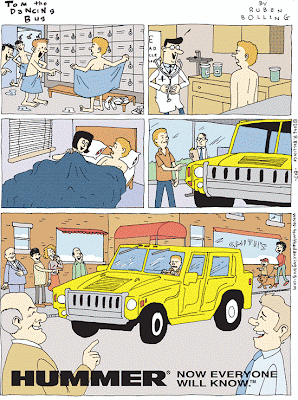I’m still absorbing the news that the Sichuan Tengzhong Heavy Industrial Machinery Company Ltd, one of the giant industrial corporations that characterize present-day Chinese “socialism,” has purchased the Hummer brand from General Motors as the latter shuffles down the path blazed long ago by Studebaker and American Motors.
The Hummer is of course the vehicle sensible people love to hate: ugly, heavy, dangerous, gas-guzzling, polluting, military (in roughly the same sense as camouflage footsie pajamas) and a big fat macho fraud—-the damn thing is built on a regular GM SUV chassis, just like a plain old Chevy Colorado.
The psychological makeup of Hummer purchasers has been looked into more deeply, most succinctly by Ruben Bolling, the crackerjack creator of the Tom the Dancing Bug comic.
I, however, have an even more theoretical speculation on the fate of the Hummer, based on the old Marxist precept that changes in people’s consciousness tend to trail changes in material conditions. Let me draw first a brief analogy—when I spent a little time in West Africa in the early ‘80s, I met a couple of young guys, Komi and Kasimir, who were adherents of voudon (a/k/a voodoo). We talked about the belief system and they turned out to be followers of a particular fetiche or deity, which forbade them to eat anything cooked in a metal vessel or with metal utensils.
Kasimir and Komi told me of one the most dreaded of the voudon cults, whose fetiche was connected with smallpox, Its adherents would paint their faces white on sacred occasions and were feared for their ability to call disease down on enemies. Now this was only a decade since scientists and medical personnel had finally eradicated the disease in its last strongholds in Africa, so I asked if this group was still as feared as it had used to be. They both thought and said no, actually it was not as powerful and its fetiche not seen to be as deadly. Changes in consciousness trail changes in material conditions!
Back to the Hummer. The military’s HumVee was a star of the last substantial victory for the US military, Operation Desert Storm, the 1991 Gulf War. The Arnold Schwarzeneggers of the US felt uncontrollable lust and a civilian version was soon forthcoming, and became a GM product by 1998.
9/11-fueled war fever sent sales soaring even higher--for a while. But by early 2004 they were declining precipitously. I rather doubt that it was due to sudden environmental concerns among its target audience. I think what happened is that fairly early in the occupation of Iraq, it became clear that this mighty war wagon could be taken out by a couple of Baghdad teenagers with a big artillery round and a garage door opener. Whether people thought about it consciously or not, IEDs had taken the bloom off the rose.
I don’t know what Sichuan Tengzhong Heavy Industrial Machinery Company management is thinking. I can’t see a big Hummer comeback in the US and the contribution they’d make to China’s already horrific pollution boggles the mind. Indications are they plan to market these vehicular plug-uglies more heavily in developing nation markets. I can only say I hope they take a richly deserved bath on this venture.



4 comments:
Don't have much of an opinion on Hummers. I tend to think many people see their cars as a reflection of their status, class, etc. So some drive tahoes and denalis, other benzs and bimmers, volvos, prius and elements and fancy subarus. I will tell you that in Las Vegas I saw TONS of hummers and most of them were driven by women.
I don't think anything's settled yet.
"A domestic company's purchase of the gas-guzzling Hummer brand is against China's economic situation and the country's development, said an official with the Development Research Center of the State Council, the country's Cabinet, Tuesday."
http://www.chinadaily.com.cn/china/2009-06/09/content_8265391.htm
Here's the deal…
Everyone who can afford to own a personal vehicle fulfills self-image fantasies when buying a car. The Hummer may seem like the most extreme example, but at the port we unload cars that cost half-a-million-dollars (and more), so the search to "prove the size of my hardware" by the vehicle I drive (as Ruben Bollings' excellent cartoon explains it) actually has several more frightening examples.
As a former automobile assembler I can add that the merchandizing of a so-called "consumerized" Humvee has gone through a few steps. The H2 (which replaced the Hummer), as Jimmy points out, is built on a standard SUV chassis and is simply made to look wider so, in auto marketing terms, it has a "more aggressive profile." The newer H3 is built on the same S10 frame as the GM toy-pickup truck that began its life as the Chevy LUV in 1972 (a rebadged Isuzu, the KB) which was projected at the time as more fuel efficient in response to the oil crisis of that period.
The self-image thing, as Saoirse's comment indicates, takes many forms. A South Park cartoon (that framed its joke on environmental concern about smog) projected a "Smug" crisis-- the target audience for Toyota's Prius is people who want to feel good about themselves, feel like they're contributing something positive. Many engineers, on the other hand, feel smug about driving a "sensible" cheap vehicle. In US consumer culture there is nothing unique about buying a car to attempt to fulfill fantasies.
What all this tells us about the designs of the new capitalists who've overturned socialism in the PRC is a topic for deeper minds than mine.
I drive a Ford Focus. I like the Mini Cooper but I won't pay twice as much for a car because it's cute. There was an interesting article a few years ago in The New Yorker about why people buy big cars. It may explain why women buy Hummers as mentioned in a previous comment. here is the link to the article:
http://www.gladwell.com/2004/2004_01_12_a_suv.html
-dbf
Post a Comment